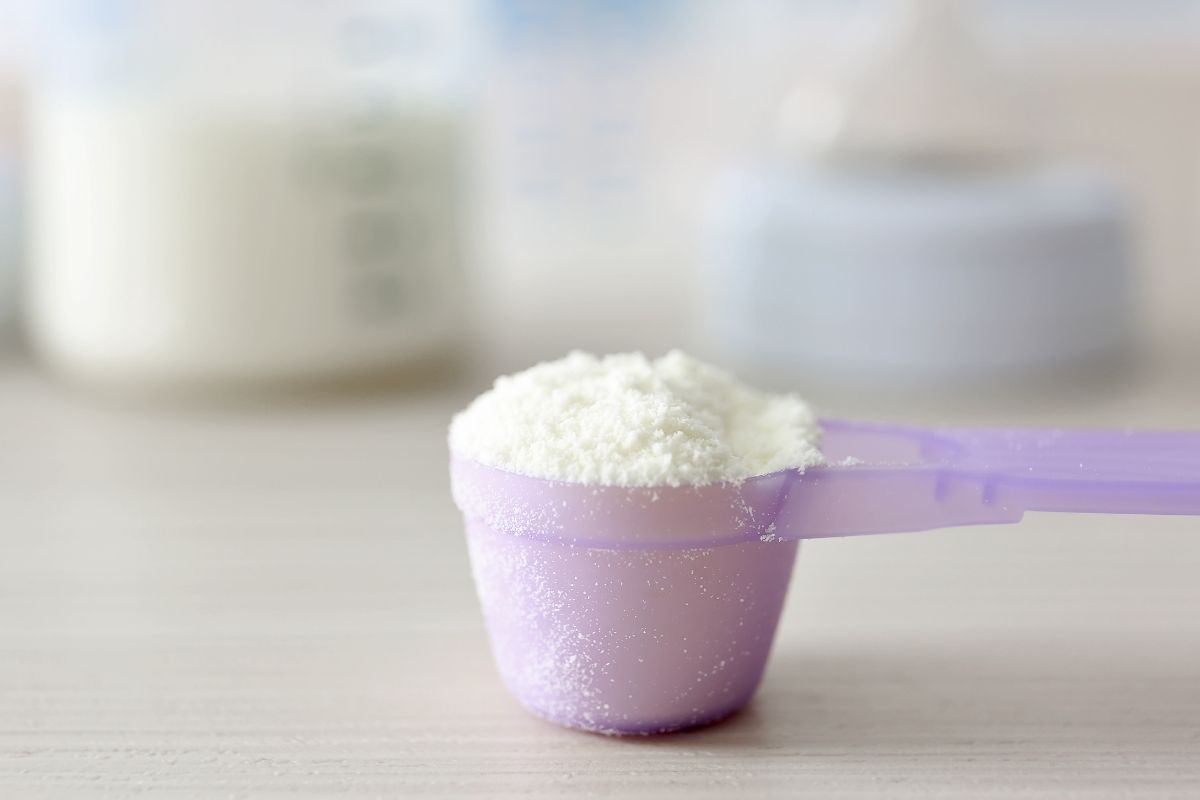
Are you a new parent struggling to decide what baby formula to choose for your little one? Look no further! In this blog, we’ll guide you through the essential ingredients in baby formula so you can make an informed decision about what’s best for your baby.
While breastfeeding is the best source of nutrition for babies, sometimes it’s not possible or preferred, and that’s where baby formula comes in. Available in powder, liquid, and ready-to-feed forms, formula provides a balance of fats, carbohydrates, proteins, vitamins, and minerals for your baby’s health.
But not all formulas are created equal! From soy-based to hypoallergenic, the ingredients can vary greatly depending on the brand and type. That’s why it’s essential to understand what you’re feeding your little one.
So, join us as we explore the ingredients found in baby formulas and what they do. By the end of this blog, you’ll have all the knowledge you need to make the right choice.
What are the different types of baby formula?
You will often see five main categories of baby formulas, each with its own nutritional makeup:
- Cow’s milk-based formula 🐄 Standard cow’s milk formulas are the most common and are often recommended for healthy babies without dietary restrictions or allergies.
- Goat’s milk formulas 🐐 In European countries, goat’s milk formula is more widely available. However, there are a few options on the US market as well.
- Organic formulas 🌱 Buying organic formula is often more expensive than non-organic formula but has some advantages. Organic baby formula ingredients are manufactured at a higher standard. They are typically non-GMO, use certified organic ingredients, and are made without the use of synthetic pesticides or fertilizers. Moreover, they are free of artificial preservatives, additives, and flavors.
- Specialized formula 👩⚕️ Specialized formulas are created for babies with specific health conditions such as prematurity, gastrointestinal issues, or food allergies and are only to be used under medical supervision.
- Soy-based formula 🫘 This is a type of specialized formula that is sometimes medically recommended when a baby has lactose intolerance. Occasionally it can be used for babies with cow’s milk protein allergy (CMPA), but other times it’s not suitable as some babies with CMPA also have an allergy to soy.
Moreover, different kinds of milk are offered as powdered formula, liquid formula, and ready-to-feed formula. We will discuss special formulas in more depth below, but please remember these formulas should not be used unless recommended by your doctor!
Specialty formulas
Special infant formulas can help manage your little one’s medical conditions and unique dietary requirements. If you suspect your baby has an allergy or intolerance, you should discuss with your pediatrician whether a special formula may help. This next section will discuss the kinds of special formulas available!
Low-lactose and lactose-free formulas
Lactose-free and low-lactose formulas are used for infants with lactose intolerance. They are created with alternative carbohydrate sources to lactose, such as maltodextrin and corn syrup solids.
Hypoallergenic infant formulas
Hypoallergenic formula is intended for babies with allergies. These formulas contain hydrolyzed milk proteins. The hydrolysis process breaks the proteins into peptides, which are smaller pieces of proteins that can be partially or extensively hydrolyzed depending on the degree of hydrolysis. These broken-down milk proteins are less likely to produce allergic reactions and are more easily digested.
Protein sources found in infant formula
Protein is one of the main building blocks for developing healthy muscles, organs, and bones. If you didn’t know, babies grow more during their first year of life than they do during the rest of their lives, so protein is a crucial part of a healthy infant diet!
You will typically see three main protein sources when shopping for baby formula, which we’ll cover now.
Cow’s milk-based baby formula
Standard milk-based formulas are made with milk from cows. Cow’s milk-based formula and breast milk have two main milk proteins: casein and whey. The ratio of these proteins in cow’s milk formula is adjusted depending on your baby’s age to reflect the natural changes that occur throughout lactation and to mimic human milk better.
It’s also for this reason that lactose is typically the primary carbohydrate source in formula milk, just like breast milk. This natural milk sugar aids in absorbing minerals and promotes gut health.
Soy-based baby formula
This type of formula is made with protein from soybeans and is fortified with the necessary vitamins and minerals, such as zinc, calcium, and iron, to mimic the nutrients in breast milk.
A soy-based formula can be an excellent alternative for babies with lactose intolerance and for some cases of CMPA. However, it is important to be aware that soy can cause an allergic reaction in 10% to 14% of infants with CMPA.
Babies with lactose intolerance are deficient in the enzyme lactase, which allows the body to break down lactose into energy for the body to use. This issue with unabsorbed lactose is that it can cause babies discomfort, dehydration, and diarrhea.
Soy-based formulas should only be used when lactose intolerance or CMPA is present and when recommended by a doctor. While soy formula can provide babies with adequate nutrition for growth and development, a cow’s milk formula or breast milk is still preferred if your baby is healthy and has no intolerances to milk.
Hydrolyzed and extensively hydrolyzed baby formula
Hydrolyzed formulas are an alternative for infants with gastrointestinal issues or allergies. Hydrolyzed milk proteins have been enzymatically treated with hydrolase to create easily digestible, less allergenic peptides. In simpler terms, milk proteins are broken down into easy-to-digest particles for infants.
There are two types of hydrolyzed formulas, partially hydrolyzed and extensively hydrolyzed. The proteins in the partially hydrolyzed formula are broken down into large pieces, while extensively hydrolyzed proteins are broken into even smaller compounds.
Partially hydrolyzed milk may be labeled as gentle or comfort formula, designed to be softer on digestion, and extensively hydrolyzed protein formulas are reserved for babies with cow’s milk protein allergy.
Carbohydrate sources found in baby formula
Now that we’ve given you a more comprehensive look at the kinds of baby formula available and different protein sources, we will explain the importance of carbs!
Carbohydrates are a major energy source for infants. Depending on the type of baby formula, you will see various carbohydrate sources. Some of the more popular choices amongst manufacturers include lactose, corn syrup, or maltodextrin.
Lactose
Lactose is a disaccharide comprising two simple sugar molecules: glucose and galactose. It is usually the primary carbohydrate source in milk-based formulas, but soy formula does not include lactose, which suits infants with potential intolerances to this ingredient.
Lactose is the natural sugar found in all milk and is used to help resemble the carbohydrates in human milk better, feed healthy gut bacteria, protect infants against infections, and build a more robust gut microbiome!
Corn Syrup and High Fructose Corn Syrup
Corn syrup solids, also known as glucose, are commonly found in specialty formulas to compensate for the less pleasant taste of hydrolyzed milk proteins and to replace lactose as the main carbohydrate energy source in these formulas.
It’s important to be aware that not all corn syrup is the same; there are “regular” corn syrups and high-fructose corn syrups. We’ll walk you through the differences between these two carbs.
The corn syrup found in infant formula is rehydrated, dried corn solids, which we know as glucose or liquid corn syrup. It is less processed than its sibling, high-fructose corn syrup. High-fructose corn syrup is sweeter than corn syrup because of its further processing and the addition of fructose.
Not all baby formula has corn syrup or high-fructose corn syrup, and European formulas skip out on these ingredients altogether. In America, formulas with added corn syrup are usually labeled as “gentle.” They are primarily recommended for infants with colic or fussiness who may have intolerances to lactose.
If you prefer a baby formula without corn syrup or added sugars, read the ingredient list on the back of the formula to ensure none is added.
Maltodextrin: An Alternative to Corn Syrup
Maltodextrin is another easily digestible alternative to lactose found in some sensitive and hypoallergenic formulas. It is less sweet than corn syrup and can improve the texture of foods.
Maltodextrin is a corn, rice, potato, or wheat starch, and the starch is broken down, purified, and spray-dried into powder form. While derived from plants, it is still a highly processed carbohydrate source.
However, as we’ve discussed so far, infants must receive carbohydrates to grow and develop. Therefore, maltodextrin is a safe alternative to lactose in standard, hypoallergenic, dairy-free, and hydrolyzed baby formulas!
Fat sources in infant formula and breast milk
Cow milk and human milk have different fat content and composition. Therefore, to mimic the complex lipids naturally found in human milk, manufacturers remove the butterfat from cow’s milk and replace it with easily digestible vegetable oils. They may also include essential fatty acids such as docosahexaenoic acid (DHA) and arachidonic acid (ARA), known to support brain and eye development.
Vegetable oils
Vegetable oils are easy for infants to digest and are nutritionally similar in makeup to butterfat. A few different vegetable oils found in baby formulas are:
- Palm oil 🌴
- Coconut oil 🥥
- Soy oil 🫘
- Sunflower oil 🌻
ARA and DHA
Docosahexaenoic acid (DHA) and arachidonic acid (ARA) are two long-chain polyunsaturated fatty acids naturally found in breast milk.
Interested in diving deeper? Don’t miss our comprehensive guide: Why DHA in Formula is Important
Since 1996, DHA and ARA have been added to some infant formulas in America due to their role in the development and function of the brain and eyes during the early stages of life.
However, DHA is a mandatory ingredient in all infant formulas in Europe, and manufacturers often add it in an equal ratio to ARA.
Vitamins and minerals
Vitamins and minerals are essential for infant growth for both breastfed and formula-fed babies. Vitamin D, iron, and zinc are some of the most crucial baby formula ingredients; let’s discuss their role for your little one!
Vitamin D helps build strong bones along with other minerals like calcium and phosphorous. Iron helps red blood cells carry oxygen through the body and supports learning. Lastly, zinc is vital for immunity and the proper functioning of our smell and taste.
As far as vitamins go, B vitamins, including B12, support brain development and produce healthy red blood cells. Folic acid is another type of B vitamin important for your baby’s overall well-being as it is essential for producing red blood cells and DNA synthesis.
Prebiotics and probiotics
Prebiotics are dietary fibers that can improve gut flora. They are added to formulas to potentially improve the gastrointestinal tract in infants to help resemble that of breastfed babies.
On the other hand, probiotics are live bacteria that contribute to a healthy gut. They help stop the growth of unwanted bacteria and infections in the stomach. Often, probiotics are used to treat diarrhea and eczema in infants. Prebiotics and probiotics are more commonly found in European formulas.
Final Thoughts
Choosing the best infant formula for your baby can be overwhelming and stressful when the options are endless, so here are a few tips to take with you on your formula-finding journey:
- Determine if formula feeding is best for your family. Weigh the pros and cons of all feeding options available to you, and reach out to your pediatrician or a lactation consultant for guidance and support.
- Research infant formula manufacturers and choose a company that aligns with your values, with high safety standards, and of course, a formula suited to your baby’s unique needs.
- Read the baby formula ingredients list carefully to avoid unwanted additives.
- Take milk protein allergy into consideration; if you suspect your baby has allergies, seek the help of a healthcare professional.
We hope our information allows you to make better, more informed decisions regarding baby formula, its ingredients.
Frequently asked questions
Related articles

- /
Changes in Your Baby’s Poop After Starting Solids

- /
Baby Acne: Breast Milk as a Potential Cure

- /









